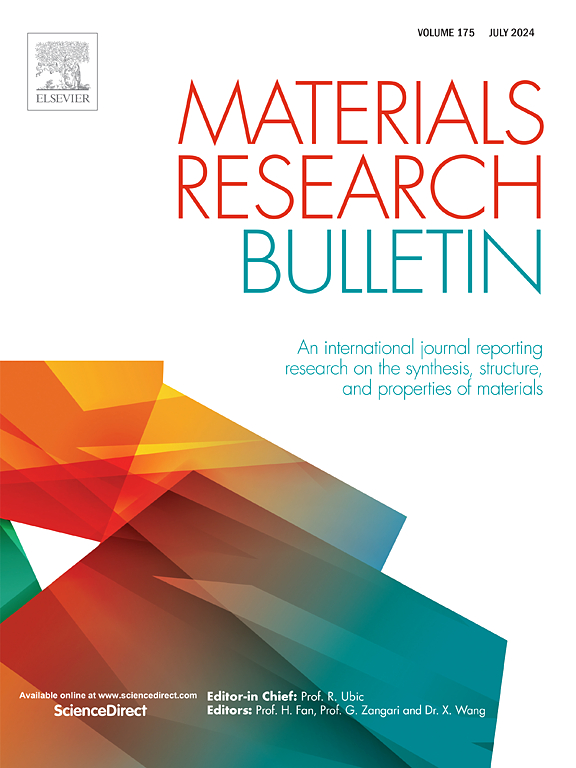Mn1−xSnxTe composite nanocubes synthesized by hydrothermal method for optoelectronic and dielectric applications
IF 5.3
3区 材料科学
Q2 MATERIALS SCIENCE, MULTIDISCIPLINARY
引用次数: 0
Abstract
The dielectric materials based on Mn-Sn-Te are in demand for their unique properties like minimum loss, satisfactory temperature stability, and extensive energy storage capability. The present work reports on the alterations in structural, optical, and dielectric characteristics of Mn1−xSnxTe (0.1, 0.25, 0.5, 0.75, and 0.9) composite by the variation in Mn and Sn content, which were synthesized by single-step hydrothermal method. The X-ray diffraction study confirmed the cubic form of the crystallites with a decrease in crystallite size from 71 nm to 23 nm, whereas the dislocation and strain values increased as the Mn amount decreased in the composition. The presence of two polycrystalline phases, MnTe and SnTe, was observed from the Raman analysis. The TEM analysis confirmed the presence of these two phases with a lattice spacing of 1.58 Å for the SnTe (400) and 1.30 Å for the MnTe (144) plane. Large reflectance was found from the high Mn content sample, and these samples exhibit low bandgap values, which decreased from 0.63 eV to 0.41 eV with a decrease in Mn content. The refractive index increased from 3.86 to 4.35 with the decrease in Mn content. The morphological analysis through FESEM showed the nanocubes. The EDX study showed the presence of all the constituent elements in the synthesized samples, which was also supported by the XPS analysis. The dielectric constant and AC conductivity were found to be more at higher temperatures. The prepared sample showed a maximum dielectric constant of 339,435 for 400 °C sample at 1 KHz frequency. Applications for electronic and energy storage devices may benefit from the SnMnS matrix's aforementioned optical, electrical, and dielectric characteristics.

水热法制备Mn1−xSnxTe复合纳米立方,用于光电和介电应用
基于Mn-Sn-Te的介电材料因其具有损耗小、温度稳定性好、储能能力强等独特性能而备受青睐。本文报道了单步水热法合成的Mn1−xSnxTe(0.1, 0.25, 0.5, 0.75和0.9)复合材料Mn和Sn含量的变化对其结构、光学和介电特性的影响。x射线衍射研究证实了晶体的立方形态,晶体尺寸从71 nm减小到23 nm,而位错和应变值随着成分中Mn含量的减少而增加。通过拉曼光谱分析,观察到MnTe和SnTe两种多晶相的存在。TEM分析证实了这两种相的存在,SnTe(400)和MnTe(144)的晶格间距分别为1.58 Å和1.30 Å。高Mn含量样品的反射率较大,且带隙值较低,随Mn含量的降低,带隙值从0.63 eV降至0.41 eV。随着Mn含量的降低,折射率由3.86增加到4.35。FESEM的形貌分析显示了纳米立方体。EDX研究表明合成样品中存在所有组成元素,XPS分析也支持这一点。在较高的温度下,介电常数和交流电导率更高。在所制备的样品中,当样品温度为400℃,频率为1khz时,最大介电常数为339435。电子和能量存储设备的应用可能受益于SnMnS矩阵的上述光学、电学和介电特性。
本文章由计算机程序翻译,如有差异,请以英文原文为准。
求助全文
约1分钟内获得全文
求助全文
来源期刊

Materials Research Bulletin
工程技术-材料科学:综合
CiteScore
9.80
自引率
5.60%
发文量
372
审稿时长
42 days
期刊介绍:
Materials Research Bulletin is an international journal reporting high-impact research on processing-structure-property relationships in functional materials and nanomaterials with interesting electronic, magnetic, optical, thermal, mechanical or catalytic properties. Papers purely on thermodynamics or theoretical calculations (e.g., density functional theory) do not fall within the scope of the journal unless they also demonstrate a clear link to physical properties. Topics covered include functional materials (e.g., dielectrics, pyroelectrics, piezoelectrics, ferroelectrics, relaxors, thermoelectrics, etc.); electrochemistry and solid-state ionics (e.g., photovoltaics, batteries, sensors, and fuel cells); nanomaterials, graphene, and nanocomposites; luminescence and photocatalysis; crystal-structure and defect-structure analysis; novel electronics; non-crystalline solids; flexible electronics; protein-material interactions; and polymeric ion-exchange membranes.
 求助内容:
求助内容: 应助结果提醒方式:
应助结果提醒方式:


